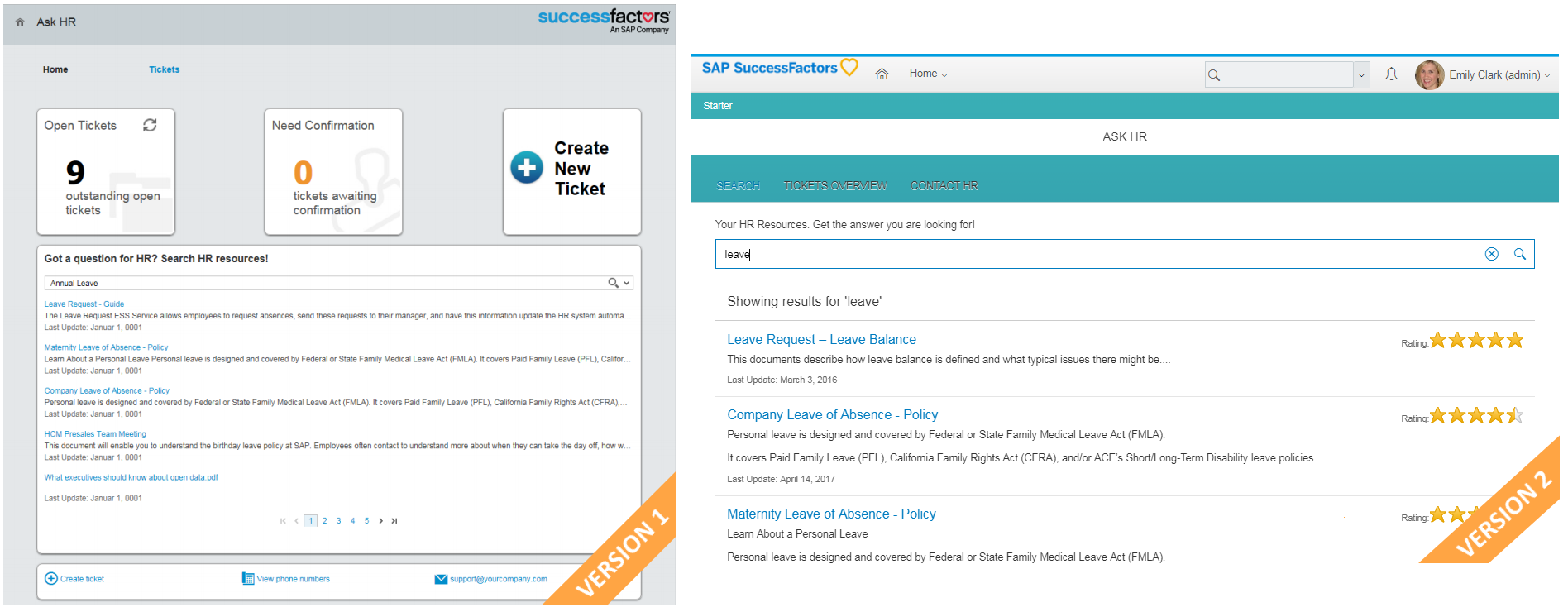H1 2020 : SuccessFactors Employee Central Service Centre
25 May 2020It may be the first SuccessFactors release of 2020, but we are already up to the second release for Employee Central Service Centre, as Cloud for Customer (C4C) remains on a quarterly release cycle. In this release, it is like someone opened the flood gates on “useful for Employee Central Service Centre users” ideas and we had a barrage of updates and improvements that would take me an article easily twice as big to cover. I usually drop the features that are least likely to be useful. In this release, I have had to use a higher bar in making the selection of what to write about. Inevitably, this has resulted in a much higher number of features than usual being relegated to obscurity. And you know what? That is great!
In this release, there is a considerable amount of value to be taken up. As a result, in this article, I’ll be running through what I see as the key changes. Once you have everything from the article in hand and under consideration, if you do have time, go and dig a little deeper into SAP’s release notes for C4C (due for release mid-May on the SAP Customer Experience Wiki). There are a whole host of user interface changes that are going to make the lives of your service agents and administrators that much easier.
With that in mind, I will kick off with a look at Cloud for Customer and some updates to the ubiquitous communication channel of e-mail.
C4C
As always with C4C functionality, there is a range of options in regards to the enabling of features. Some features such as changes to how areas of the user interface work will simply apply automatically. Other features may require screen adaptation or changes to a set of configuration. The deeper features, however, may require more foundational changes within fine-tuning or scoping. The exact requirements may vary based on your existing C4C configuration.
C4C’s e-mail functionality is once again receiving several enhancements in the latest release. The first of these enhancements that I want to mention is the automatic loading of inline images when a service agent replies to or forwards an e-mail.
Just as with your e-mail application of choice, C4C will no longer require you to have to re-add images to an e-mail where they are relevant to your subsequent e-mail. Perhaps this is not so much of an issue when replying, but when forwarding, it is typically essential to include all the original mail content, including attachments and embedded images. This behaviour change is a welcome one as it will make it quicker and easier to reply/forward with images intact, and time is something service agents need to process tickets efficiently.
Searching of e-mails in the list view of e-mail interactions has now been enabled. This change allows a service agent to search for a term in both the subject line and the body of an e-mail in a pop-up window. When the service agent selects an e-mail, the e-mail is then displayed in the interaction list.
To this point, it has been possible to create standard e-mail response templates in plain text that user agents can use to provide canned responses to a query. This change is a huge time saver, and while broader text templating solutions often provide more control and flexibility, the ability to use tokens is a crucial factor to their success in the system. Now, SAP has added the ability to use HTML-based templates.
HTML is the syntax used to mark-up information for use in a web page. Modern e-mail clients also support it, and so while this is destined to make e-mail responses somewhat prettier and more modern, the big benefit will be the way hyperlinks can be used and described, and additional media such as images included inline. This change will allow canned responses to be more efficiently written with fewer words and greater content. One example is that the description for the link can be the link. Another example is that images can be embedded where they make sense rather than being a separate link or a disembodied attachment. You can create these templates externally to C4C and then import them, meaning that you can use whatever HTML tools you might already have to help create them. But HTML can be created just as well in a simple text editor where needs are simple, and I would advocate keeping things simple.
The system also now provides options for favouriting and cloning templates. That’s quite a few updates to help those who are already using templates. It is also an excellent reason to incite those who are not to take another look.

Along similar lines to response templates is the corporate branding of responses. It has been possible to enable this branding, but not to disable service agents from overriding it with another template or clearing it. Until now, that is. SAP has introduced a new global setting to restrict access to doing this in an attempt to ensure consistent and correct branding. However, for me, it presents the questions which service agents would have been going to the effort of changing the branding, and why?
The last e-mail functionality enhancement to highlight is that it is now possible for administrators to monitor outbound e-mails. This monitoring is useful for investigating e-mail delivery issues. I have had numerous occasions in implementations where this would have proven very useful in discussions with both SAP and with local IT teams supporting e-mail services. I have also been involved in a handful of post-go-live support tickets where e-mails had apparently gone astray. This information fills a gap that has always had people pointing to it as the most likely source of an issue. To date, it has never turned out to be the case, but it stands to reason that it could have been. Access to this information will help determine if an e-mail delivery issue is indeed a configuration issue, an SAP mail service delivery issue, or an issue on the receiving mail server end such as whitelisting for a filter being required, or the set-up of the Domain Keys Identified Mail (DKIM) to trust the sending service.

##Internal Memo A relatively recent addition, internal memos are a new and improved way to add notes to tickets that can only be seen by the C4C users, and not via Ask HR. Internal memos allow service agents to compile internal records that will be used to feedback to the employee or notes that are process-related and of no interest to the employee, but essential nonetheless to the processing of the ticket.
SAP has enhanced internal memos such that the author can now update them up to the point that a new interaction is added by someone else. This update period allows for typos to be corrected, general revisions made, and a running list of information to be kept in a single note to that point. Subsequently, to add additional information, a new internal memo must be created.
Workflows
Workflows are a powerful automation feature within Employee Central Service Centre and one that I try to encourage customers to make good use of. The more options workflow can offer, the greater the range of automations that can be implemented.
In the H1 2020 release, ticket-based e-mail workflow rules gain a couple of new additional fields that can be used for determining if a rule will be triggered. These fields are Created On and Changed On. With them, administrators will be able to set-up rules for things like additional/alternative notifications during holiday periods, for example.
Timeline View
The timeline view is receiving a handful of updates in this release, with my favourite being that all date/time entries will be shown in line with the user date/time preferences. It does make me wonder why this was not already the case. I hate the pain of having to manually calculate time differences across multiple time zones, considering daylight saving time offsets that vary when they apply by location. Any system that deals with this automatically for me gets a thumbs up from me as it saves time and the potential for miscalculation. The more time zones your service centre spans, the more useful this feature will be to your service agents.
I would tie the next couple of features into second place for timeline view updates. Service agents will now have an easier time of working with e-mails and tickets with the inclusion of options to reply to an e-mail and to split, copy and move actions.
While replying to an e-mail previously, what happened was that C4C applied functionality that was, in reality, a reply to all. In the majority of cases, this was fine. Still, as soon as people were cc’d, this meant that responses directed to the sender only had to be tailored to manually remove the other recipients – something which did not always occur. The new split of reply and reply all make this an explicit decision by the service agent, thus providing an easier one-click option that the agent explicitly chooses for the purpose of replying to the sender, or all previous recipients.
In regards to splitting, copying and moving, the options to take action and start a new ticket from it (split), or to add (copy) or transfer (move) the action to an existing ticket have been available in the system, but just not in the timeline view. This minor update is something that many service agents will use daily to split out multiple requests, for example. Adding this into the timeline action options makes the timeline view that much more useful by bringing parity with the interactions view and allowing the service agent to retain their focus.
Next up, the update includes the option to add extension fields on the timeline list view. If you have custom data that you would find useful to see in the timeline view, take a look at enabling the fields you require. I am not sure what the envisaged use case is for this, but I’m also never one to turn down additional flexibility in a system.
Finally, saving service agents one click at a time is the tweak that will automatically open the details of the most recent timeline entry when the list is first loaded. It may just be a saving of one click, but this adds up, and it makes for a more positive user experience which is probably the real win for this one.
But That’s Not All
Before I wrap up on the C4C side of things, I wanted to pick out some additional updates. This section of the article is far from everything else that Employee Central Service Centre users can make use of in this release. There have been so many interface adjustments across the board and tweaks to existing functionality that will improve system use for service agents in this release; my notes were about three times as long as usual when analysing this release. There are simply too many to cover in this article. But there are a set of updates that I think are particularly noteworthy that I simply had to bring to everyone’s attention.
The first one I want to highlight is that template use can now be reported on. This news is fantastic for administrators, who can use this to gain insight into things such as how many times particular response templates are used, or how the utilisation changes over time. In particular, this will help highlight under utilised templates and templates that are no longer fit for purpose. Good housekeeping is a trait of any good administrator. ‘A clean system is a happy system’, after all.
Sticking with templates, as well as e-mail templates, C4C supports templates for portal responses. The templating system has now been updated to support rich content rather than just plain text, so this is an excellent time to check your templates and see if any could be refreshed to take advantage of rich content.
Lastly, it would hardly be any sort of SuccessFactors update these days without the appearance of some kind of Qualtrics integration. C4C has been updated to allow Qualtrics surveys to set as the data origin type code for tickets. With Human Experience Management (HXM) now being the approach of the moment, the proactive and automatic creation of tickets as a result of feedback gathering is a fascinating idea and one which could have profound effects if appropriately handled and detrimental ones if left unchecked.
I would absolutely encourage organisations to start looking into this, but please do so with caution. A small-scale pilot, which you can gather yet more feedback from (I’m spotting a theme here) is the way to go. The last thing you want is to be inundated with automatically generated tickets and then fail to be able to deliver to service level agreements. This scenario would demotivate service staff and employees. But, if you analyse the pilot and grow it out in a balanced manner, I can see the potential here to deliver a next-generation service alongside machine learning supported ticket analysis and resolution.
Ask HR
Deprecation of Ask HR v1 For those customers on version one of Ask HR, you have hopefully been contacted by SAP to discuss the update of Ask HR to version two. This deprecation was highlighted in last year’s Employee Central Service Centre roadmap information. It is a critical step in taking your Employee Central Service Centre implementation forward as Ask HR v1 has not been actively developed for several years now.

The update process is much less painful than the original Ask HR v1 implementation process. SAP carry out a large proportion of the technical instantiation behind the scenes. Ask HR v2 is also an app subscription rather than an isolated installation, meaning it is easier to enable in general.
Switching to v2 will give you access to the bi-annual updates, but it may require some re-architecting of the Ask HR component of the solution. V2 is still less configurable than v1 because v2 is a shared code base for the application and offers less in the way of customisation. An example of this would be if you have customised page layout (for example to accommodate a SharePoint-based knowledge base), you may have to work very closely with SAP to find a suitable approach to maintain such existing functionality.
Hopefully, this drive from SAP will help them focus on delivering more flexibility to the customisation of the application before the end of the year. It is certainly something that they have indicated an intention for in the past.
Updates
It is not often that Ask HR gets updates that I would call significant or exciting, but in this release, I think that SAP has put in some particularly useful updates.
First up is that an employee can now create a ticket on behalf of another employee. Raising tickets on behalf of another employee is something that has come up in every ECSC implementation I have worked on. Process-based solutions have been based on things such as only accepting such requests by telephone, putting the details in capitals at the top of an e-mail or portal submission and hoping the service agent picks up on it, or merely keeping the ticket as is and “owning” it on behalf of the other colleague. All that is now addressed by the option for specifying the ‘affected user’ for the ticket.
Next is a feature I am sure was present in v1, and that is Employees can now close a ticket directly from Ask HR. Why this was not included years ago, I will never know. At least employees will have it going forwards, and service agents will not be required to do it on their behalf – which to my mind was an unnecessary waste of everyone’s valuable time.
The next feature, I must admit to not even realising that it was not currently an option. When searching for tickets, to this point, only the subject line of the ticket could be searched. But now the search will also attempt to match the ID of the ticket. For many employees, who are only dealing with an occasional ticket, this will make no difference. Employees who by the nature of their job create many tickets (e.g. HR representatives, departmental heads, etc.) will find this useful as it gives them a way to distinguish tickets that may be very similarly titled. This situation will be particularly evident when searching back through previous tickets as that list can grow to be rather extensive for these users.
The final update for Ask HR is that it is now possible to enable different service catalogues for different countries. Unlike the other options, this one needs some additional configuration around the service catalogues and country associations.
I am not sold on this needing to be an option. We live in a global society and corporations follow-suit. There is an economy of scale and benefit of shared expertise when operating a global shared service centre, and similarly a global organisation. Consistency is key to effective operation, and while there are always local requirements (I’m looking at you in particular payroll), these can be accommodated within a global process. Such global processes to my mind need just one global service catalogue. Maybe this option will be useful to me at some point in the future, but I think I will be guiding customers towards a cohesive and consistent approach that spans organisations as a whole.
Mobile Application Support
The SuccessFactors mobile application support for Ask HR received a welcome feature bump in February 2020 that customers have obviously been enjoying for several months. These updates applied to both the Android and Apple mobile platforms, and included an option to hide the priority field, a feature that came to the desktop browser back in Q3 2019, and an option to display only open tickets, a .
Conclusion
Many of the updates bring long overdue parity. Others bring implementation of what I refer to as common sense features, the ones you think “what wasn’t that there from the start?” They are not flashy updates, but they are updates that will make a big difference in terms of efficiency through ease of use and speed improvements, through to simply ensuring users see the system developing in positive ways for them.
Other updates are bringing with them new functionality and, I will be keeping an eye out for news of the uptake of Qualtrics with Employee Central Service Centre.
For any of you still using Ask HR v1, if you have not started your migration to v2 yet, do. At the very least, get the communication channels with SAP opened. Particularly if you have any customisations that you do not think will be covered by Ask HR v2. SAP needs to understand what is required in such circumstances, and you need to have confidence in the migration process and ultimately, the results.
Finally, if you missed my Q1 article, do check back for it on the blog. There may be a whole quarter of updates you are already missing out on.
 Scroll the menu to find all the places to visit
Scroll the menu to find all the places to visit


